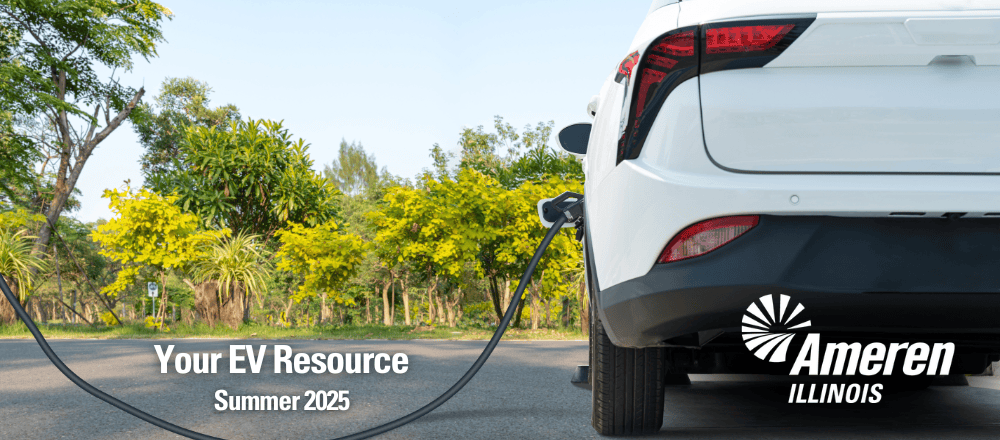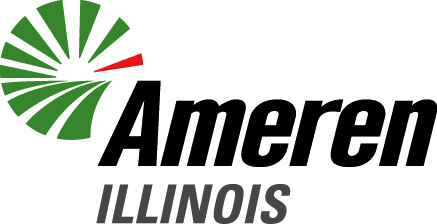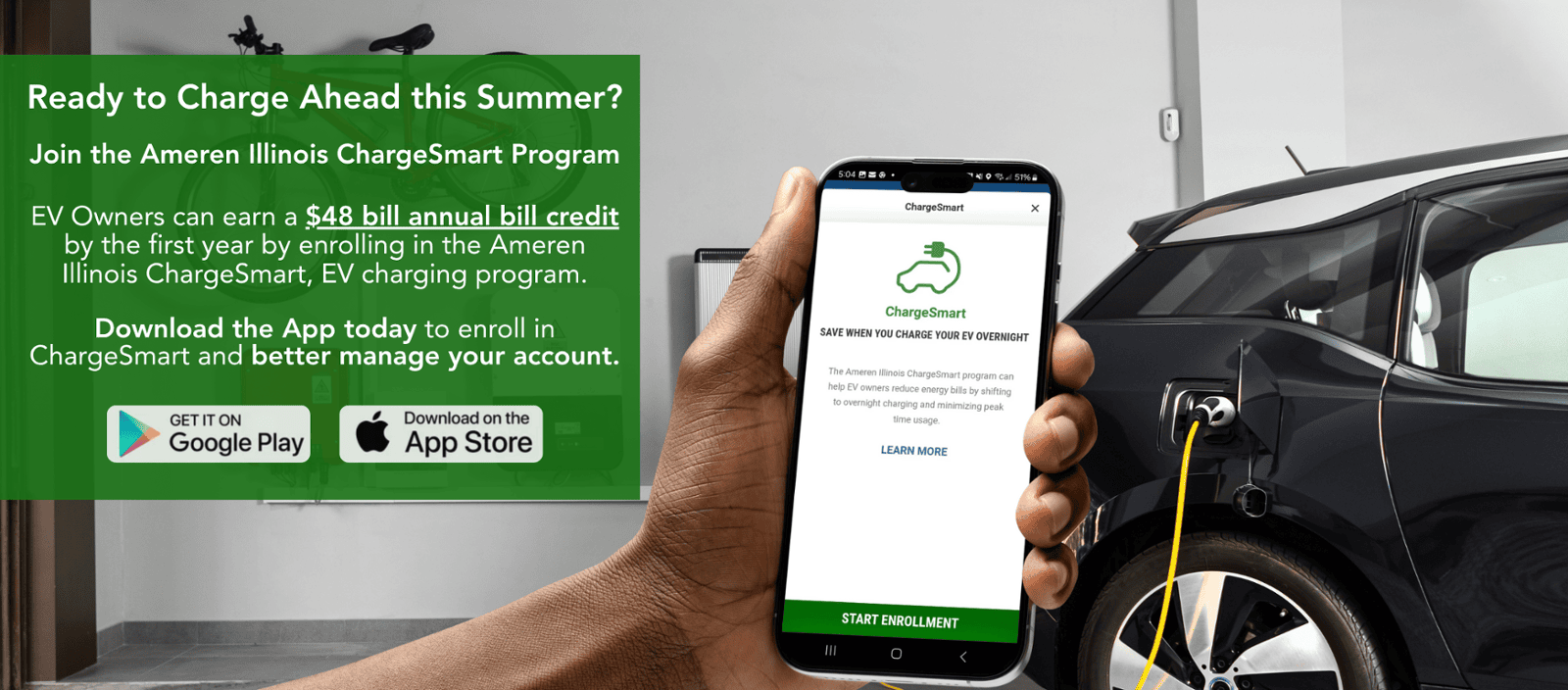Ameren Illinois EV Newsletter - Summer 2025
Ameren Illinois EV Newsletter - Summer 2025

From Gas Pumps to Charging Ports: How Public Charging is Evolving


EV Owner Spotlight


Driving Electric with Purpose and Care: Dia Parr’s EV Journey
But functionality wasn’t her only motivation. Her husband, Al, has long been active in the local green movement, helping organize EV shows through their church, First Christian Church (Disciples of Christ). These events have brought the community together, featuring everything from Teslas to a 1955 Spider sports car that was converted to electric. The shows have been so successful that local dealers, Ameren, and Southern Illinois University have stepped in as sponsors.
“I really like my car,” Dia says. Her Ariya gets over 300 miles of range in the summer —plenty for round trips to St. Louis, which she makes frequently for Cardinals games, performances at the Fox Theatre, and her son’s medical appointments. “I estimate we travel to St. Louis at least 20 to 25 times a year.” To expand her charging options on longer road trips, Dia recently purchased a Tesla adapter to access more fast-charging stations. She and Al are currently planning a road trip to Iowa this May to visit family.
Dia primarily charges at home using a Level 2 Wallbox charger, which Nissan helped her purchase at a discount. “Installing the charger was pretty seamless,” she says. They’ve set their charger to automatically power up between 11 p.m. and 7 a.m., taking advantage of Ameren Illinois’ ChargeSmart Program which rewards EV drivers with monthly bill credits for charging during the Preferred Charging Period.
While her experience has been largely positive, Dia acknowledges there's a learning curve to driving electric—particularly when it comes to planning for charging stops. Dia is quick to recommend EVs to others. “They’re quiet, smooth, and fun to drive. People think they’re slow, but they’re not! Surprisingly, most people don’t even realize she’s driving electric. “Nobody has asked me about it yet,” she says with a laugh. “But it feels good to drive something that’s helping reduce emissions.”
For Dia, the shift to an EV has been more than just a new mode of transportation—it’s become another opportunity to learn and share her experience with the community she’s always called home.

EV Market Preview


Find the right at-home charging solution
Charging at home is the most convenient option. With a home charging station, you simply plug in your vehicle and forget it. When you’re ready to hit the road, your car is too.
While the idea of finding and installing a home charger might feel overwhelming, Ameren Illinois simplifies the process with a step-by-step guide and a variety of online resources. If you're unsure where to begin your search for a home charging station, our website offers tools to compare equipment, locate certified electricians, and explore available incentives.
Choosing the Right Home Charging Solution
The first decision you'll need to make is which level of charging best suits your needs:
Level 1 Charging
This option uses a standard 120V outlet and provides about 4–5 miles of range per hour. It's best for drivers with short daily commutes (under 40 miles) and usually doesn't require any additional installation.
Level 2 Charging
This faster option uses a 240V outlet—similar to what you’d use for a clothes dryer—and delivers approximately 25 miles of range per hour. While it typically requires professional installation, it’s ideal for drivers with longer commutes or multiple daily trips.
Comparing and Purchasing Chargers
Once you’ve narrowed down your charger preferences, use Ameren’s Charger Comparison Tool to explore specific models and features.
Many of these chargers are available online or through local electricians and EV supply stores. If you're unsure where to purchase, Ameren’s EV Partner Network and website are great starting points for locating trusted vendors and installers near you.
Right now, Ameren Illinois residential customers can claim an exclusive $50 rebate on a Blink HQ 200 Home Charger through the Online Marketplace. Don’t forget to check with your vehicle manufacturer for additional incentives or discounts on home chargers.
Ameren Illinois provides tools, tips, and checklists to guide you through every step of the home charging journey. Whether you’re just starting your EV research or ready to install a charger, we’ve made the process as smooth and pain-free as possible.

Ask the Ameren EV Expert


How Much Does It Cost to Install a Charger at Home?
- Distance from the electrical panel: Longer wiring increases cost
- Garage: Detached garages may require trenching or overhead wiring
- Basement type: Finished basements take more labor to work around
- Panel capacity: Homes with limited electrical capacity may need an upgrade
- Age of the home: Older houses may need additional updates to meet code
Installation Prep and Incentives Information
- Use a certified installer. Qualified customers may get free installation and a rebate. Visit the Ameren Illinois EV Partner Network to see if you qualify and to find an installer.
- A federal tax credit may be available. You may be able to save up to 30% (up to $1,000) for residential charging installation.
The best time to plan your charging setup is before your EV arrives. Knowing what your home needs and what the installation might cost can help you avoid surprises and make confident choices.

Upcoming Events

Join Ameren at the vibrant Fiesta in Florissant!
Free For All
Saturday, June 21, 2025
10:00 AM – 10:00 PM
Sunday, June 22, 202511:00 AM – 9:00 PM Ameren will be on site until 6:00 PM both days.
Knights of Columbus Park50 St. Francois Street, Florissant, MO 63031
Sunday, June 22, 2025
Fiesta in Florissant brings together more than 15,000 people each year to enjoy live Latino bands, folkloric dancers, authentic foods from Latin America, Hispanic arts and crafts, a car show, and a children’s pavilion full of activities for the whole family.
Join Ameren Illinois at Kicks on 66!
Free For All
Saturday, September 6, 2025
11:00 AM
Ray M. Schon Park,
Glen Carbon, IL
Hosted along the iconic Route 66, Kicks on 66 is a family-friendly event featuring classic and custom cars, live music, kids’ activities, food vendors, and more. While you're there, visit the Ameren Illinois booth to take a ride-along in an EV and have all your questions answered by experts.
We hope to see you there!

